Plastic panels for the bathroom: description, varieties and tips for choosing
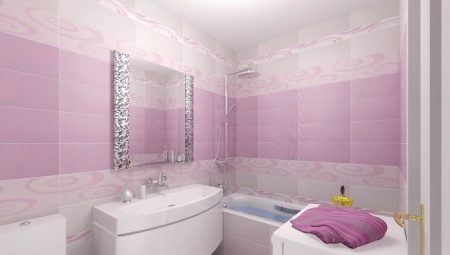
It is no secret that the aesthetic perception of any room is largely determined by the background cladding. When it comes to the bathroom, most buyers tend to opt for plastic panels. In this article, we will look at their key features, advantages, disadvantages, mounting methods and design options. In addition, we note what you need to pay attention to when buying this material.
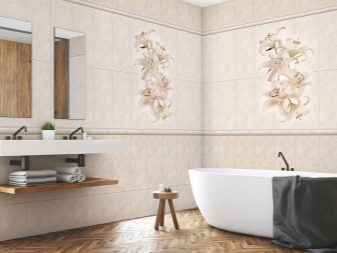

Features, pros and cons
Plastic panels are considered one of the most popular cladding materials. With their help, you can create a stylish interior with an atmosphere of coziness and comfort in the room without any special financial investments. In fact, This is a piece of paneling of various sizes and thicknesses, the purpose of which is to decorate walls or ceilings. The material is an alternative to ceramic tiles, however, in comparison with it, it has advantages in installation.
PVC panels have different strength indicators, the level of resistance to mechanical damage, which is why it is necessary to select them correctly for the bathroom. They are made from polyvinyl chloride, to which chlorine and ethylene are added. The binder used to be lead; today, calcium and zinc are used instead (in equal proportions).
The composition allows you to obtain a material with optimal strength and flexibility.
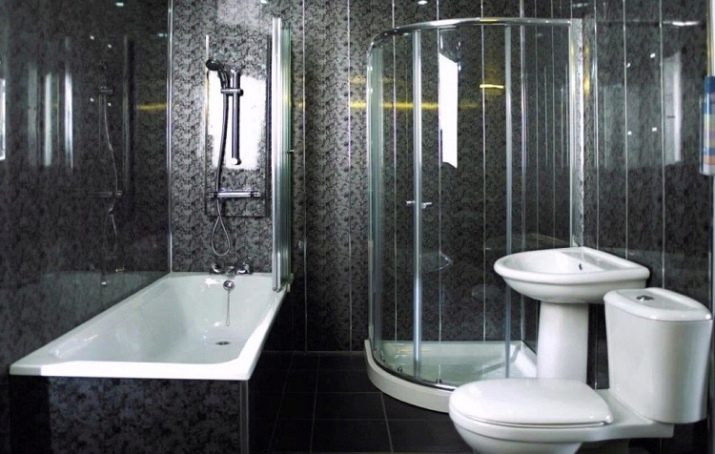
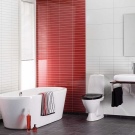
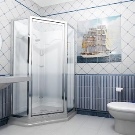
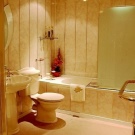
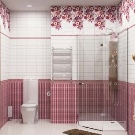

Panels are obtained by pouring a liquid mass into molds of different sizes. After the panel has cooled down, a decorative coating is applied to it. Using another technology, the print is printed on a film, after which it is glued to the front side of the panels.The decorative layer is very thin, therefore it is necessary to protect sheet material from mechanical damage and overly diligent cleaning.
The panels are variable in texture: they can be not only smooth and varnished, but also embossed and mosaic. A different type of texture, coupled with a pattern, allows you to create an imitation of any finishing material. Due to this feature, the cladding is able to imitate expensive materials (for example, stone, elite types of wood, marble, decorative brick).
The choice of imitation is huge, you can even find in the assortment a design for a material that does not exist in nature.
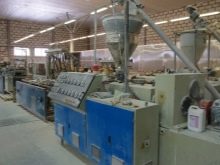


Plastic is considered a durable material, with careful handling it can serve for more than 10-15 years. The covering of the panels does not need complicated maintenance, the material is adapted to the temperature drop in the bathroom and the level of humidity in the room. Its inertness to moisture makes it resistant to moisture - the panels are not afraid of mold or mildew. It will not be destroyed by microbes, it will not fade.
The plasticity of the material allows it to be used not only for cladding standard walls and ceilings, it is also suitable for cladding arched openings and rounded shapes. With the correct production technology and taking into account the requirements of GOST, the panels are odorless and comply with all necessary safety standards. It is not difficult to work with them, such repairs can be done on your own without the involvement of a specialist from the outside.
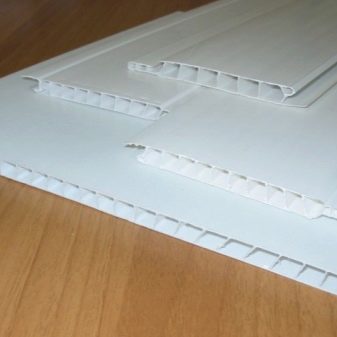
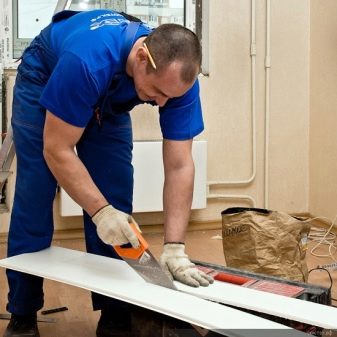
PVC panels have many advantages.
- The material has high aesthetic characteristics, with the right choice, it can be used to change the style of the interior.
- The product is hi-tech, since the production uses high-quality raw materials and modern equipment.
- The panels are variable in the choice of color solutions; if you wish, you can choose several halftones of a particular color and pattern.
- The material does not deform during operation and does not shrink, the panels firmly adhere to the walls and ceiling until dismantling.
- The panels are not picky about the type of base, often the installation does not need any preliminary preparation at all.
- Through this cladding, you can mask the imperfections of the base, as well as hide communications.
- Material in the bathroom can be used to sheathe not only the walls and ceiling, they can be used to decorate the bath screen, the cabinet under the washbasin.
- The panels are suitable for the background decoration of the bathtub, from which expressive accents and elements of interior zoning are obtained.
- The cladding is easy to dismantle, if it leaks, it is removed, the defect is identified and the cause is eliminated, then put in place.
- If desired, the panels can be removed and replaced, and the frame remains in place, which simplifies installation.
- Plastic panels are perfectly combined with other finishing materials (decorative stone, tiles, mosaics).

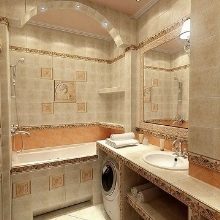

Along with its advantages, plastic sheathing has its drawbacks.
- The material itself is not afraid of dampness, but this does not exclude the appearance of condensation or mold on the walls, because no leaks are visible under the cladding.
- Installation will require accuracy, with excessive pressure, the material will simply break.
- The adhesive fastening method is considered short-lived, in this case dismantling becomes more difficult.
- The frame created for installation steals useful space, which is bad for rooms in small apartments and houses.
- When cutting panels with a grinder, an unpleasant odor is sometimes emitted, therefore this work must be carried out in a protective mask.
- A cheap material does not always have a good decorative layer; it can wear off during the maintenance of the coating.
- The panels do not withstand shocks and heavy loads, scratches and defects significantly spoil their appearance.
- The material is flammable, emits suffocating smoke in the event of a fire and burns very intensely.
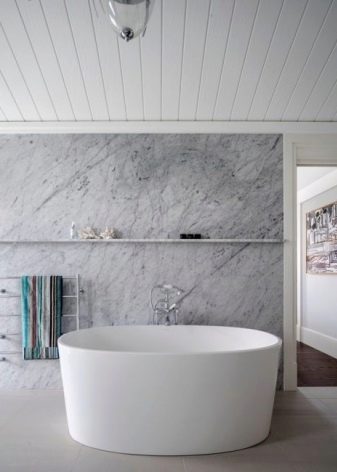
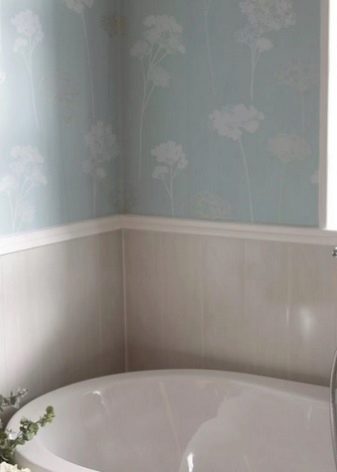
Views
It is possible to classify PVC panels for bathroom cladding according to different criteria. For example, by the type of overlap, they are ceiling and wall (wall).Despite the fact that both types of material are 2 thin sheets of plastic connected by stiffeners, the difference is noticeable in thickness. The ceiling options are thinner and are designed to reduce the weight load on the floor.
According to the form, modifications can be divided into 3 types: rack, standard and sheet. Variants of the first type are similar to long and narrow stripes, in most cases they are plain and rustic. Due to their size, they create a single-type design that requires softening of perception, because it is undesirable to fix them both on the ceiling and on the walls.
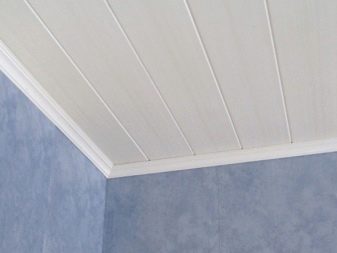
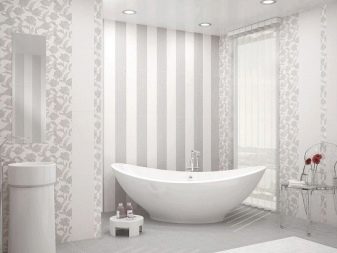
PVC lining is distinguished by a sanded type of surface and provides for connection using special spikes. It is produced in two variations: eurolining and "polka". Euro lining has wide, and "polka" narrow locking systems. In this case, the dimensions of the lamellas of the two types are identical.
Standard (classic) panels retain the shape of an elongated strip. Externally, this material has a length from floor to ceiling with an optimal width. Depending on the subject of the drawing, they can create a different atmosphere. Their thickness can be different, as well as the texture (for example, it can be glossy or matte). However, unlike other options, it is smooth.
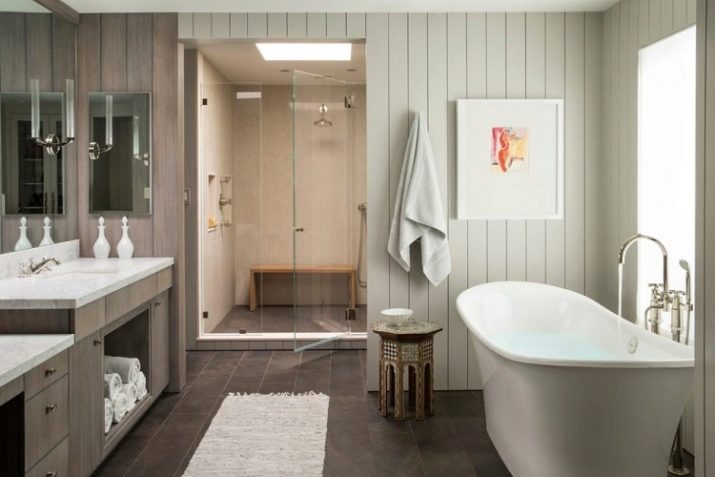
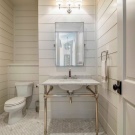
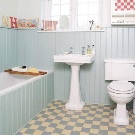
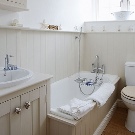

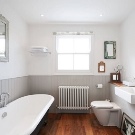
Today, manufacturers produce not only a two-layer type of plastic panels. In addition to it, there is a plastic sheet without cells (jumpers) on sale. Its thickness is very small (3 mm), in fact, it is plastic with a pattern applied to its front surface. It is this type of cladding that is used for the adhesive fastening method. It does not take up valuable centimeters of a limited area and does not need to create a frame as a fastening base.
Tiled panels are nothing more than a plastic interpretation of tiles. Such material is used for cladding spacious bathrooms. In addition, it greatly simplifies the cladding of a standard-sized bathroom. The shape of this type of cladding can be square or rectangular, its dimensions are usually larger than typical ceramics.
In fact, this type of panel can be called tiled blocks that go well with other finishing materials.
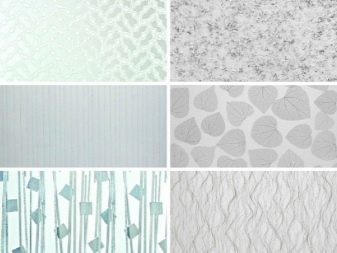
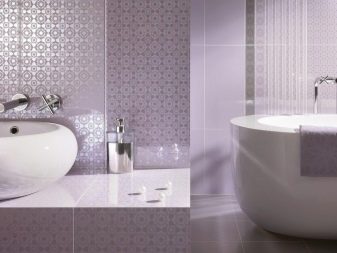
Sheet material differs in its dimensions. It is not as long as typical lamellas, but due to its size, it allows you to minimize the repair time. Often, it is a certain composition with a pattern that is assembled, like puzzles, into a single picture. A bathroom trimmed with such a finish, even with a simple imitation of some material, looks impressive and modern.
Panels differ by type of attachment. Some of them are performed using a suture technique, others are mounted using a seamless technology. Others are characterized by the presence of a chamfer. The use of a seamless method allows you to create a design that is not visually divided into separate fragments of a single picture. Despite the fact that the joints will be barely visible, this will not spoil the overall appearance of the cladding.
Beveled plastic decorative panels differ externally: these are options with a recess for joining into a single canvas.
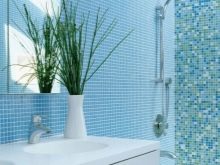
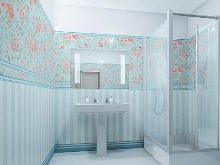
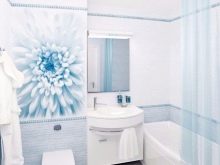
Dimensions (edit)
The parameters of plastic bathroom panels depend on their type, they vary in length and width. For example, the length of the lamellas can be 120, 270, 300, 395 cm. Due to the variety of choices, you can choose the option with the smallest trimming, which minimizes the cost of cladding. In addition, you can find panels on sale, the length of which is about 6 m, which is good for covering the ceilings of spacious bathrooms.
The width of the building material can be from 10 to 50 cm. In this case, as a rule, narrow width options have a visible connection (seams). Analogues with a width of 25 cm and more are characterized by a smaller docking joint. Panels with a width of 30 and 37.5 cm are considered a universal type of cladding, they are bought more often, choosing a thickness equal to 1 cm.
The choice of thickness is not accidental: the larger it is, the stronger the cladding. And if it is difficult for the ceiling material to reach, then the wall must to some extent withstand mechanical damage. Ceiling slats are usually 0.5 to 0.8 cm thick, wall slats - 1 cm. As for individual varieties, everything is individual. For example, tile materials can have dimensions of 30x30, 98x98, 100x100 cm. Usually their thickness does not exceed 5 mm.
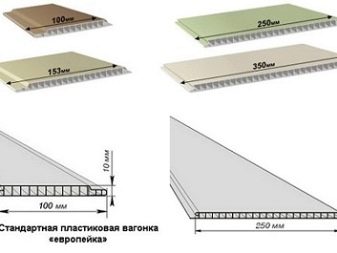
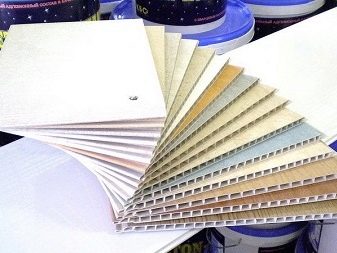
Wall panels of a standard type with a length of 260, 270, 300 cm have a width of up to half a meter. Sheet counterparts are larger than tiled ones, although, in fact, they are the same rectangles. Their width varies between 50-122 cm, the length can be from 90 to 245 cm. The thickness of this cladding can be very thin (just over 1 mm) or standard (6 mm). Laminated panels are up to 12 mm wide.
Lining and long panels also have their priority sizes. The thickness of the two types of material can vary from 4 to 8 (10) mm. The parameters of the lining are smaller: usually the length and width of the strip are 90-300x10 cm, the dimensions of the lamellas "from floor to ceiling" are 300x30 cm. As for the relief modifications, their minimum thickness is 8 mm.
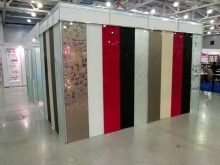


Mounting methods
Installation of plastic panels can be carried out using different technologies. To date, there are 2 methods of fastening this cladding: frame and frameless methods. Wherein each type of panel has its own technology. For example, sheet material and large plastic lining are attached exclusively to the crate. This is explained by the large size of the material used. The tiled variety is attached only to glue.
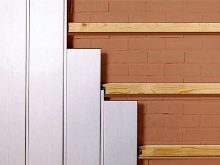

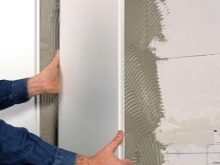
Frameless
The frameless technique for attaching plastic panels involves gluing the panels to the prepared base. In fact, this is an option when the cladding is glued to the walls or ceiling. This technique is used in rooms with flat walls or ceilings. In addition, it is good for small bathrooms (for example, in small-sized Khrushchev bathtubs or small combined bathrooms).
In order for the cladding to turn out to be of high quality, the base is preliminarily prepared, achieving a minimum difference in height. And if depressions are still allowed, then there should be no bumps on the base at all. It is necessary to glue seamless lamellas on liquid nails; dowels are used along the upper and lower edges for additional fixation.
In addition, other adhesives recommended for plastic can be used in the work.
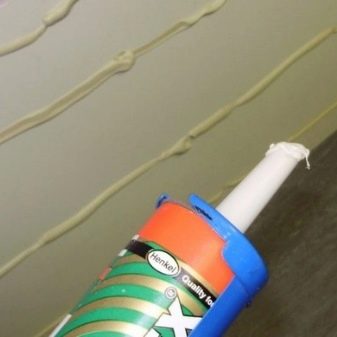

Wireframe
The technology consists in creating the so-called lathing, to which the lamellas are subsequently attached. The frame can be either metal or wood. When the panels are attached directly to it, a stapler or even regular nails are sometimes used. This creates a seam covering, the lamellas are inserted one after another according to a certain pattern.
Also, when attaching to the crate, mounting clamps are used. The locking technology is convenient, it speeds up the installation. This type of installation is used mainly in large rooms and spacious bathrooms. For small ones, the frame system is not suitable: its installation will eat at least 10-15 cm of usable area.

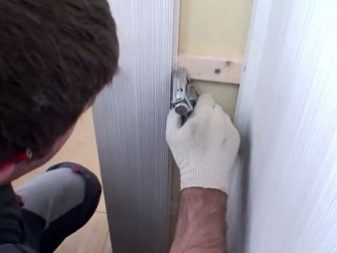
Design options
Design solutions for plastic panels can be very diverse. For example, the most popular textures that panels can imitate are brick and masonry, marble, plaster and wood finishes. However, you need to choose the right material, because it is the texture that can radically change the aesthetic perception not for the better.
The choice of large flowers or paintings of the seabed with a seascape and giant fish will not be the most successful. Today it is customary to choose a finish with prints that do not put pressure on users. The same nautical theme may be different: the print with seashells and the coast looks much better.
In this case, it is necessary to monitor the proportions: giant sinks in the bathroom are inappropriate.
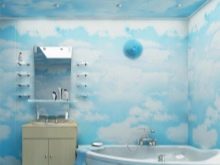
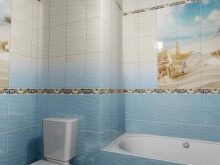
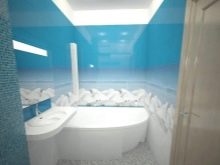
And it is completely undesirable to fill the entire background space with the same type of mosaic. If you want to use mosaic elements, it can be a small decorative panel or other finishing material. Panels can become the main background, too much mosaic creates a ripple effect.
Thermal transfer models are considered one of the best: they are the ones that buyers pay attention to in the first place. And the reason for this is not only a special technology, thanks to which a coating in the form of a polymer film is soldered onto a plastic base. These lamellas are highly durable and colorful.
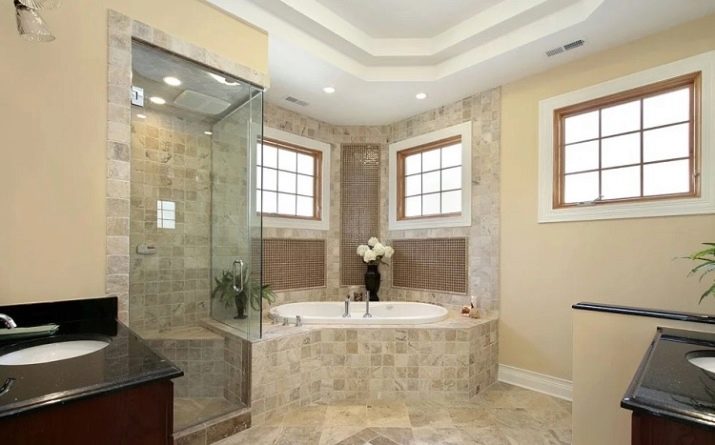


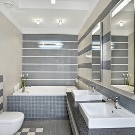
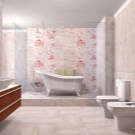

In addition to modifications with a pattern of the usual type, in the assortment of many stores there are panels with 3D effect. They give the normal material the appearance of a realistic relief. If at the same time the texture is correctly selected, then it is possible to beat the texture of different embossed materials. For example, it may not be just an option for a brick in the form of a flat base and a characteristic pattern, but a very good imitation of brickwork with protruding bricks and playing with the texture of the material itself.
The possibilities of facing material are endless. It can imitate masonry, ceramic tiles in any design and layout. These are panels with a three-dimensional effect, which literally enliven the walls, visually expand the space, and add a special flavor to it. Panels with a silk-screen effect will look beautiful in the interior of the bathroom. Moreover, they can imitate any kind of wallpaper.


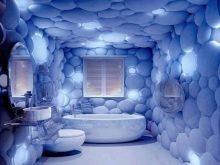
As for color solutions, then when choosing, the main colors of the apartment and the taste preferences of its owners are usually used. Colors can be delicate, almost bleached or bright, dynamic. Usually in bathrooms they try to choose building materials in light colors (white, beige, peach, caramel, cream, light coffee). Along with this, sometimes they acquire cladding in neutral colors (a combination of white with gray, silver or black).
An interesting solution can be finishing the accent part of the wall under a tree, decorative stone or gypsum brick.... Prints can convey both photographic images and watercolor painting techniques. Somewhere it will be an original panel, somewhere the effect of masonry, in the third case - meter-high slatted panels, combined with a different finishing cladding.
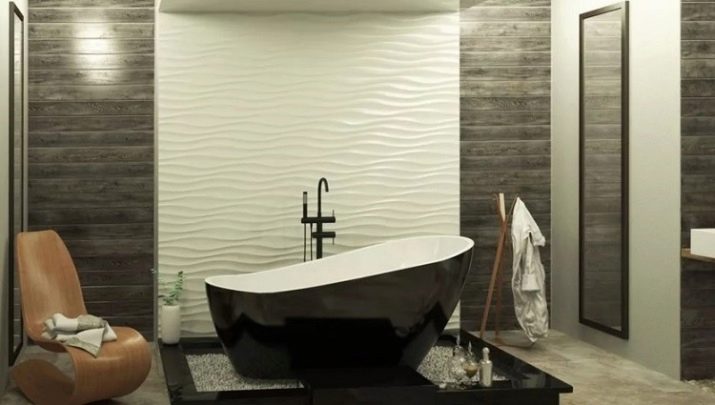

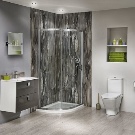
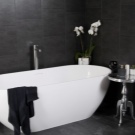
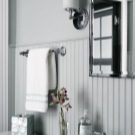

Interesting bathroom decoration ideas
A modern approach to bathroom design opens up the widest possibilities for the use of cladding. In its simplest form, it will be wall and ceiling cladding. However, if earlier it was customary to decorate all walls with the same print, today the view on creating the right background has radically changed.


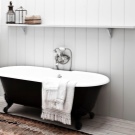
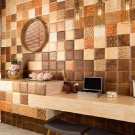
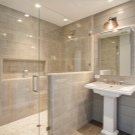
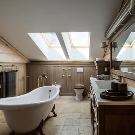
For example, today it is important to create accents using a harmonious combination of cladding materials. In fact, you need to choose at least two materials, of which one will be the background, and the second will be accent. For example, this will allow zoning the room, and at the same time relieving it of the boredom that is typical for filling the space with a single cladding.
For example, you can highlight with accent panels the wall near the bath, opposite it, behind the furniture.
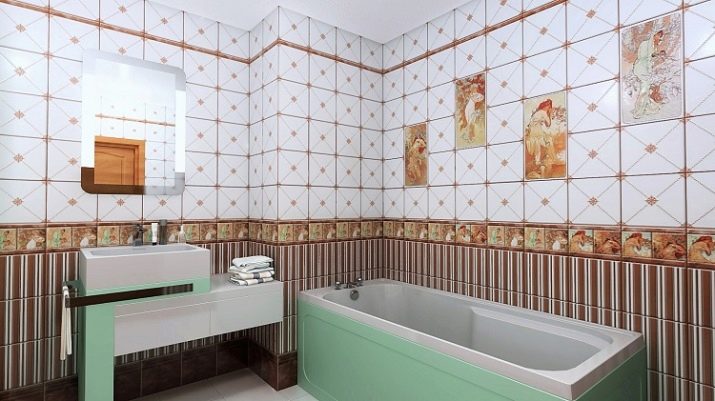
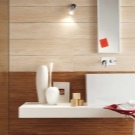
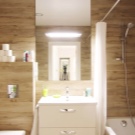
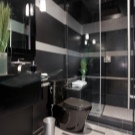
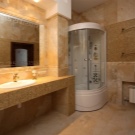

Someone trims the walls in 2 levels: at the bottom there are meter panels, at the top - imitation of wallpaper. This option looks good, say, in the direction of classic, country or Provence. In this case, the lower tier is often performed with a slight extension or the so-called imitation of a ledge. Along the upper edge, such cladding is decorated with various decor, including different types of border.
An extraordinary solution can be combination of plastic panels with glass or mirror textures, as well as materials with a reflection effect. For example, panels that imitate a metal surface and wood, clinker and wallpaper will look good in the bathroom.When a contrast of a different plan is needed, you can choose monochromatic lamellas and analogs with a print, choosing material from one series, so as not to be mistaken with shades.
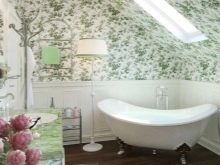


You can buy material that is the same in texture, but different in color and play on this contrast. Moreover, you can choose combinations that are typical for specific styles of interior design. For example, you can combine white with metallic, wine with wet asphalt. A wonderful tandem will turn out if you combine beige and light gray, graphite and wood, concrete and brick.
An interesting idea for decorating a bathroom can be finishing the cladding with picture film or vinyl stickers. If you choose the right theme for the drawing, you can indicate that the plating belongs to a specific interior style. For example, you can beat the design in the loft, modern, chalet, country or Provence styles. For a typical bathroom, you can buy cladding material for tiles.
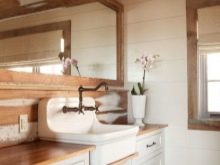
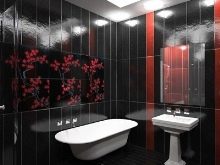
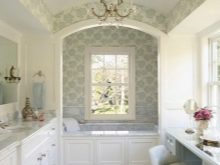
Popular designs today are ethnic paintings, all kinds of branches, vines, leaves and even damask patterns. However, style and style differ: somewhere monochromatic coatings are appropriate, somewhere - the texture of a stone. In the classic style, a contrast of a monochromatic background with gilded trim and imitation of stucco molding is required. In eco-style, a demonstration of woody texture is required.
For the classics, the use of gilding, stucco elements on the walls and ceiling is acceptable. However, completely paneling both the floor and the ceiling is not recommended. When there is too much plastic, it loses its expressiveness.
In order for it to look status and expressive, it needs opposition, contrasting texture or color.
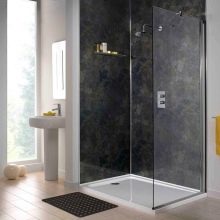

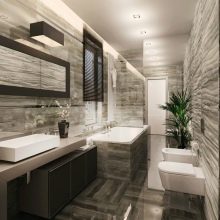
How to choose?
The choice of quality material often confuses the buyer. The situation is aggravated by the widest assortment in which you can get lost. However, no matter how much you like drawing on specific varieties, this is not the most important selection criterion. In order to choose both high-quality material and stylish cladding in one finish, you need to take into account several nuances.
- High-quality material is not cheap: the stronger and more durable it is, the higher its price.
- A good veneer has a strict geometry: it is smooth edges, whole edges, no defects and waves.
- Good panels have many stiffeners: the more partitions between the sheets, the stronger the material.
- Profiles are bought from the same batch, in different batches there may be a difference in shades, which can spoil the whole impression.
- The theme of the print is also important: drawings that create a negative atmosphere in the bathroom are excluded.
- The size of the print is selected taking into account the footage of the bathroom: the smaller the room, the simpler the print, somewhere it will not be needed at all.
- The color of the panels is selected based on the degree of illumination of the bathroom: in a small and dark room, light panels are used.
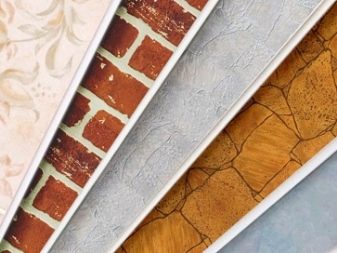
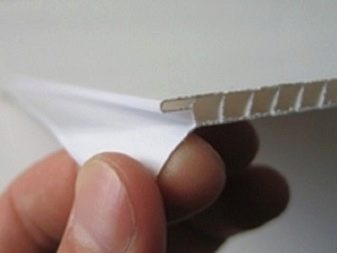
Having entered a store, a customer usually tries to find a middle ground between quality and price. However, beautiful material does not yet mean that it is suitable specifically for walls. If its thickness is small, this is a ceiling type of slats, they are cheaper than wall slats. They are less durable because they are not designed for mechanical contacts.
The larger the area of the walls, the easier it is to paste over them with dimensional materials.... It is also necessary to pay attention to temperature resistance, since it can vary between panels. In order not to doubt the quality of the purchased material, you must ask the seller for a quality certificate.
It is necessary to pay attention to the composition of raw materials: if there are no harmful components in it, it is environmentally friendly.
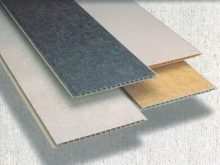
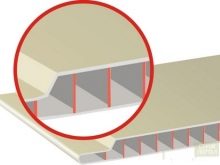

It is necessary to inspect each purchased panel, otherwise you may not notice chips and cracks, as well as scratches. Any defect is a sign of a defect; such a product should not be taken. In order for the cladding to look beautiful, it must initially be flat and intact.If the material you like is not enough, you can look at it as a "companion" or even buy another one, but in sufficient quantity.
Any building material is purchased based on the calculation of the approximate amount... In this case, the type of installation is important, because the lamellas can be fastened both along and across the walls and ceiling. In addition, attention is paid to the perception of the design itself. For example, if an option for wood looks beautiful on a showcase, this does not mean that it will create the desired design in the bathroom of a city apartment. If all the walls are decorated with such cladding, the effect of being in a wooden house or even a box is created.
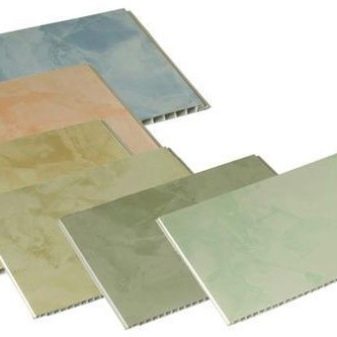
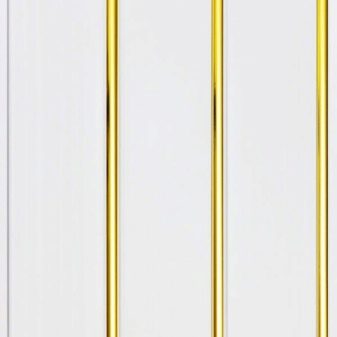
To understand which manufacturer's products should be preferred, you can pre-flip through reviews about a particular material. It is advisable to view the comments on various information portals. This will allow you to get a more realistic picture with all the pros and cons of a particular material. It is not necessary to take material 1 mm thick: in the process of work, it can be washed out. When choosing a contrasting type of finish, it must be borne in mind that a light and soft shade should prevail over a bright one. Otherwise, the panels can make the interior style unpleasant and oppressive. It is better to place the accent where it will be clearly visible.
In some cases, it can be a small panel or a narrow part of the wall, and sometimes it can be an upper curb or a constructive ledge. To make accent panels fit better with the interior, you can decorate another wall in a similar style. For example, it can be a picture on the wall behind the bathroom and a panel border opposite.
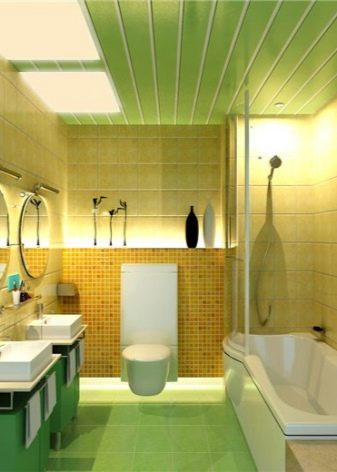

How to care?
Maintenance of plastic panels is simple. It is enough to regularly wipe them with a damp cloth, without waiting for splashes from water, which is characteristic of most apartment buildings, to appear on them. Dirt from the seams can be removed with a stiff brush or a toothbrush. In order not to push the surface of the lamellas, you should use a flannel cloth or foam sponge to clean them.
It is undesirable to use cleaning powders with abrasives. This can lead to scratches. It is better to use liquid gels, but in order to choose the right product, you need to pay attention to what kind of plastic it is intended for.

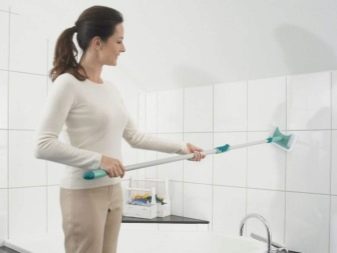
Someone washes the panels with ordinary laundry soap and then wipes them dry. In the most advanced cases, they use baking soda, applying it to the dirt and removing it after an hour.
Some people prefer to use a melamine sponge. However, anyway you need to wash the panels delicately so as not to push the material and not scratch the pattern... There is no need to rub in one place many times, there is no need to use aggressive chemicals.
If you maintain cleanliness constantly, you do not have to often perform complex manipulations.
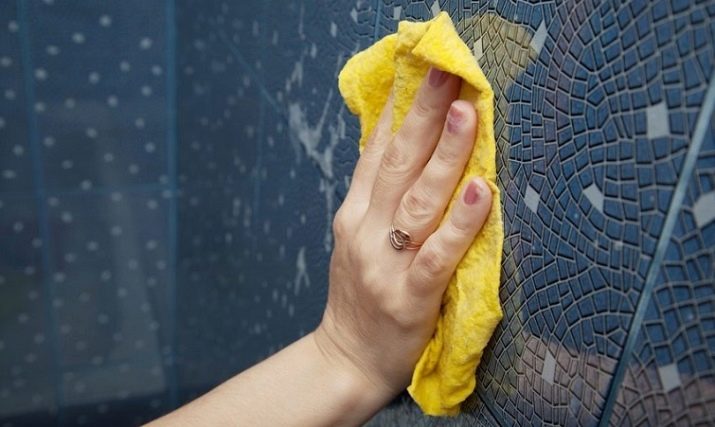
Beautiful examples of the interior
We offer 10 examples of the successful use of plastic panels in the design of the interior of the bathroom.
- Bathroom interior in style loft using marble and brick textures.
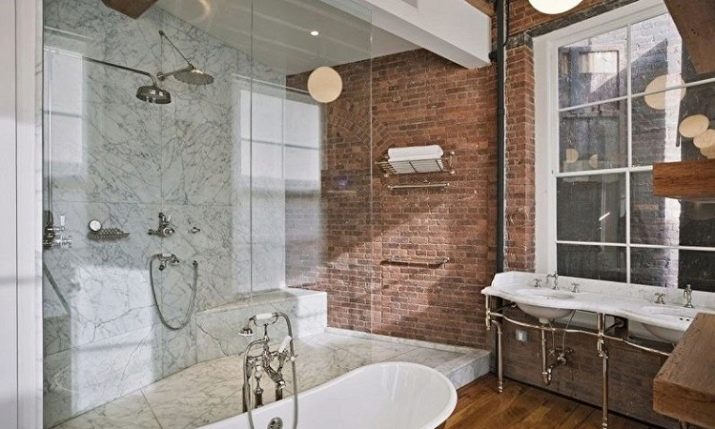
- Cladding in a contrasting color in the bathroom minimalist style.
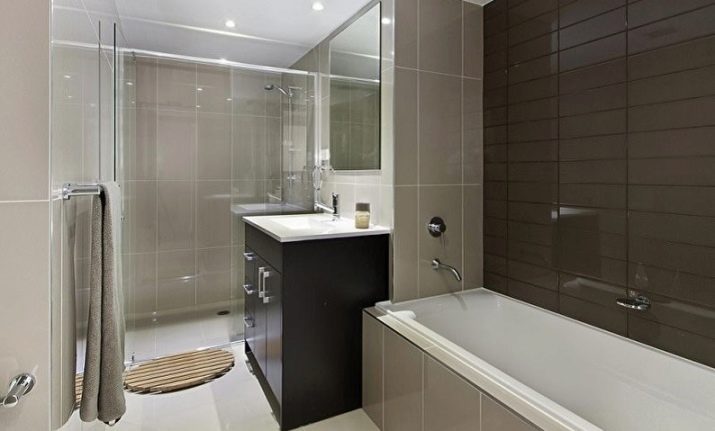
- Harmonious choice of pattern with a visual expansion of space.

- Bathroom wall cladding classic style in bright colors.

- The interior of the combined bathroom, decorated in the tradition eco-style.

- Using plastic panels for zoning space.
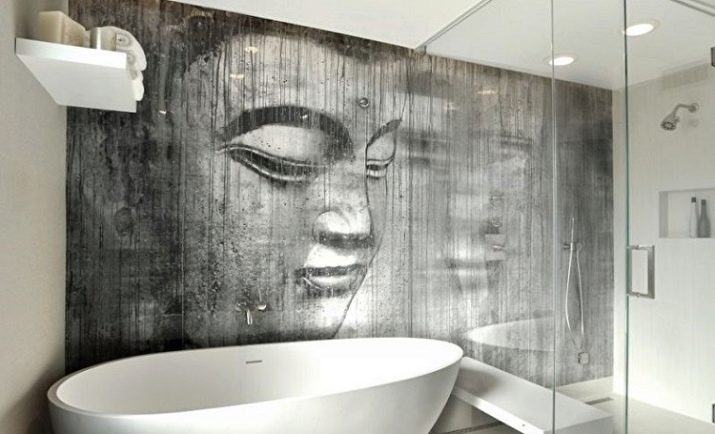
- Bathroom interior in neutral colors with accentuation of the bath area.
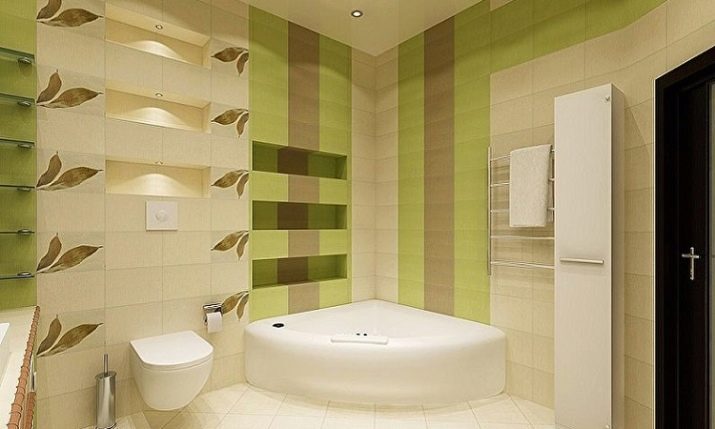
- Interesting project a combined bathroom with the use of light colors of the palette.
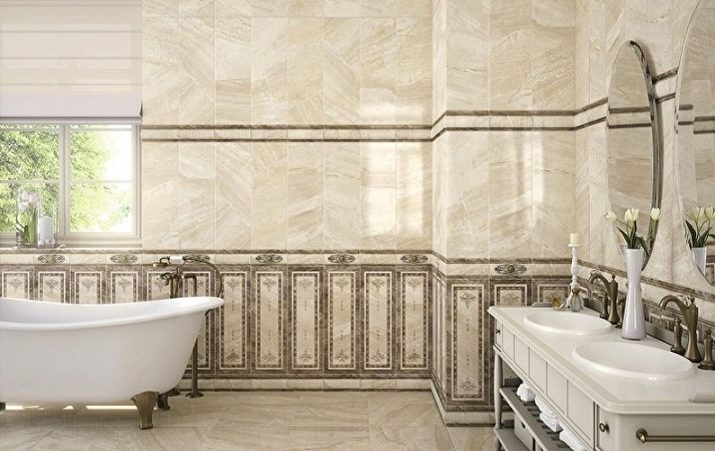
- Example contrast texture used material.
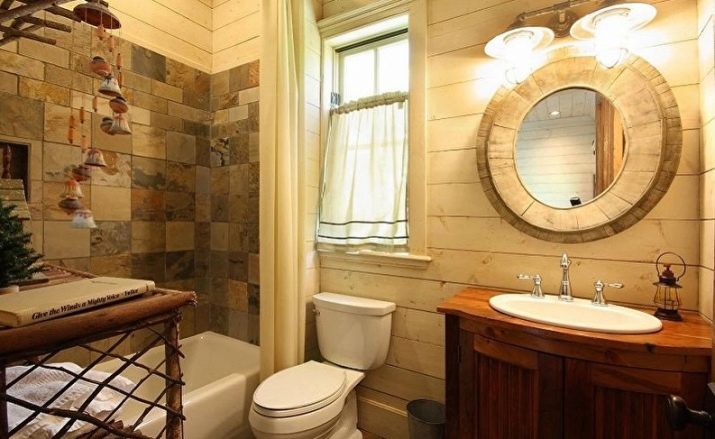
- Example dispensing large pattern, its combination with the background cladding.
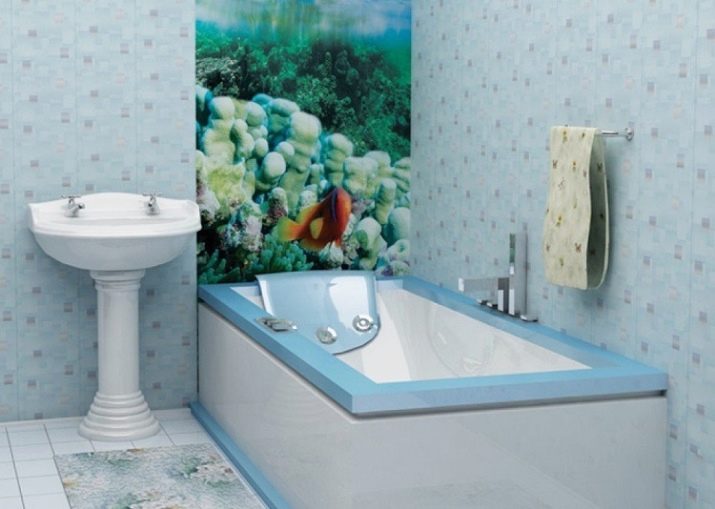
In the next video, you will find the secrets of finishing a bathroom with PVC panels.








